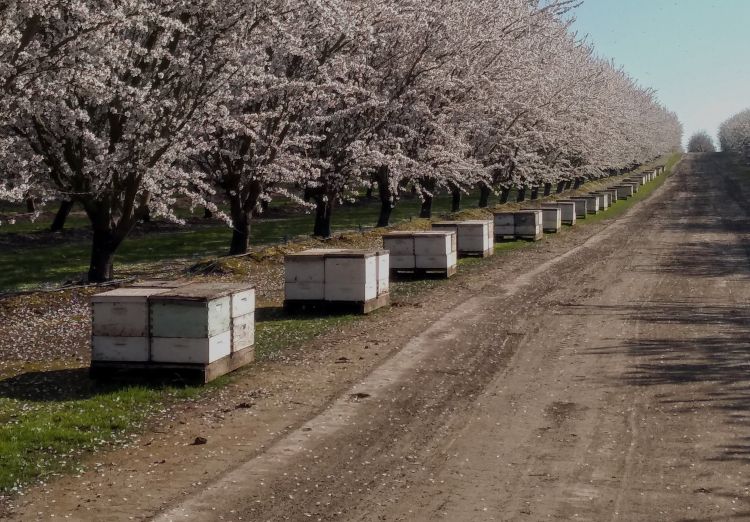Reports of high honey bee colony losses and how farmers and growers can support honey bees
Several migratory beekeepers recently reported abnormally high losses of honey bee colonies, however, losses vary across operations. Farmers and growers can support honey bee health by increasing forage and reducing pesticide exposure.

Several migratory, commercial beekeeping operations have reported high losses of honey bee colonies. According to a survey of beekeepers administered by Project Apis m., commercial operations reported an average loss of 62% between June 2024 and February 2025. These losses are much higher than the average annual honey bee losses typically reported by beekeepers, which is typically around 30-50%. According to a press release issued by Project Apis m., the Honey Bee Health Coalition, the American Beekeeping Federation, and the American Honey Producers, “Around 1.6 million colonies were lost with associated economic impacts on beekeepers are estimated at over $600 million in lost honey production, pollination income, and costs to replace colonies.” U.S. Department of Agriculture and university researchers are processing samples to try to identify causes for the colony losses, but the causes of the higher losses are currently unknown.
At this time, it is not known if or how the large losses of colonies among some beekeeping operations will affect pollination and honey production in Michigan this spring and summer. Many beekeepers split honey bee colonies that are healthy and strong in population in the spring to recuperate from the colony losses. Weather and foraging conditions can also affect whether colonies are strong enough to be split. While several large-scale beekeeping operations reported abnormally high losses of honey bee colonies, many others reported fairly standard losses.
Honey bees face many stressors that can contribute to losses:
- Varroa mites are a parasite found in all honey bee colonies in the United States. These mites spread viruses, which can lead to colony loss. Beekeepers manage varroa mites, but the efficacy of miticides can vary, and there is resistance to some products.
- Forage and habitat loss can lead to lack of adequate nutrition and can make honey bees more susceptible to other stressors.
- Climate change and weather patterns can reduce nectar and pollen availability or limit foraging conditions.
- Exposure to pesticides can kill honey bees outright or lead to sublethal effects, such as impaired memory and learning, reduced foraging, reduced lifespans, leading to weakened colonies and increased colony mortality. Many insecticides are acutely toxic to honey bees. Although formulated to manage fungi, many fungicides can have chronic effects on bees. Some combinations of pesticides applied at the same time can have synergistic effects, making them much more toxic to bees than they would be if they were applied separately. Finally, some inert ingredients, such as adjuvants, can be harmful to bees, even though they are not active ingredients in pesticide products.
Farmers and growers can support honey bees by reducing pesticide exposure and toxicity and increasing honey bee forage.
- Five steps to protect bees from pesticides
- Pollinator stewardship during fruit crop bloom
- Planning for pollination of fruit crops
- Michigan Pollinator Protection Plan Resources
- Resources for growers from Michigan Pollinator Initiative
- Pollinator Protection for Pesticide Applicators Online Course (free and eligible for one restricted use pesticide credit in Michigan upon completion)
Additional information on reports of honey bee colony losses
- Full Survey Findings: Review the detailed losses survey report – Project Apis m.
- 2025 Colony Loss Results: Survey Data and Sample Analyses - Webinar from Project Apis m.
- New Data Confirm Catastrophic Honey Bee Colony Losses, Underscoring Urgent Need for Action – Press Release from the Honey Bee Health Coalition
- Survey Reveals Over 1.1 Million Honey Bee Colonies Lost, Raising Alarm for Pollination and Agriculture - Press Release from the Honey Bee Health Coalition
- Cornell to help pinpoint cause of massive honeybee die-offs from Cornell Chronicle
- Widespread Honey Bee Colony Losses Reported – Beekeepers Input Needed - Press Release from the Almond Board of California
Acknowledgements
This work is supported by Michigan Department of Agriculture and Rural Development with funding secured from the U.S. Environmental Protection Agency for Michigan State University to implement strategies in the Managed Pollinator Protection Plan.
This work is supported by the Crop Protection and Pest Management Program [grant no 2024-70006-43569] from the USDA National Institute of Food and Agriculture.
This work is supported by the Crop Protection and Pest Management Program, project award no. 2022-70006-38001, from the U.S. Department of Agriculture’s National Institute of Food and Agriculture.
Any opinions, findings, conclusions, or recommendations expressed in this publication are those of the authors and do not necessarily reflect the view of the U.S. Department of Agriculture.



 Print
Print Email
Email




